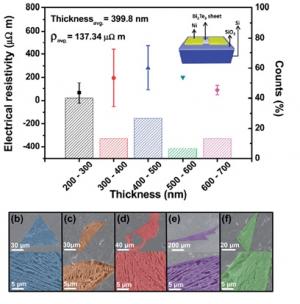Malaysian and Taiwanese researchers make major advances in dye sensitized solar cells

A set of figures illustrating the effect of applied voltage during electrolysis on the spacing between nanosheets (bottom) and the corresponding variations in electrical properties (top)
Working on dye-sensitized solar cells – researchers from University Malaya (UM) and National Tsing Hua University (NTHU) have achieved an efficiency of 1.12 %, at a fraction of the cost compared to those used by platinum devices.
This work has been accepted for publication in the journal, Nanoscale published by the Royal Society of Chemistry and has been selected for the front cover of the issue.
The study carried out in Taiwan took on the challenge of making the technology behind dye-sensitized solar cells more affordable by replacing the costly platinum counter-electrodes with bismuth telluride (Bi2Te3) nanosheet arrays.
Using a novel electrolysis process, the group managed to closely manipulate the spacing between individual nanosheets and hence control the thermal and electrical conductivity parameters to achieve the high efficiency of 1.12%, which is comparable to platinum devices, but at only at a fraction of the cost.
The research was led by Prof. Yu-Lun Chueh of the Nanoscience & Nanodevices Laboratory, NTHU, and Alireza Yaghoubi, UM HIR Young Scientist. “In light of the recent report by the United Nations about the irreversible effects of fossil fuels on climate change and as we gradually run out of economically recoverable oil reserves, we think it is necessary to look for a sustainable, yet practical source of energy” Yaghoubi stated.
Meanwhile at University Malaya, Dr. Wee Siong Chiu and colleagues were working on controlling the secondary nucleation and self-assembly in zinc oxide (ZnO), a material which is currently being scrutinized for its potential applications in dye-sensitized solar cells as well as photocatalytic reactions to generate clean electricity by splitting water under sunlight.
In this work, Dr. Chiu and Alireza Yaghoubi demonstrated a new route for synthesis of various zinc oxide nanostructures using the lipophilic interactions between a novel precursor and a number of fatty acids. They are hoping to further use this method to increase the efficiency of photocatalysts in the visible regime where most of the sunlight energy lies.
According to the researchers, if this approach is successful, generating electricity is as easy as pouring some bioinert nanomaterials into a lake and fusing the split oxygen and hydrogen atoms back into water in a photoelectrochemical cell.
This paper will be on the front cover of CrysEngComm, also published by the Royal Society of Chemistry.
MORE INFORMATION
The collaboration between UM and NTHU was set in motion after a visit by a delegate of distinguished scientists from NTHU to UM. The collaboration is aimed at tackling one of the most important challenges humankind is about to face in the coming decades.
Renewable energies have been among trending research topics in recent years, however many of the related technologies are still in their infancy and are either very expensive or not sufficiently efficient for large-scale applications.
“This is only the beginning of a long-lasting collaboration between us”, Prof. Chueh remarked.
Yaghoubi and Chueh are at the moment working as a part of an international collaboration with universities in France and USA to find a viable substitute for two-dimensional materials such as graphene which have been difficult to use in large-scale industrial applications.
Journal information
1 Hung-Wei Tsai, Tsang-Hsiu Wang, Tsung-Cheng Chan, Pei-Ju Chen, Chih-Chun Chung, Chien-Neng Liao, Alireza Yaghoubi, Eric Wei-Guang Diau, and Yu-Lun Chueh. “Fabrication of Large Scale Single Crystal Bismuth Telluride (Bi2Te3) Nanosheet Arrays by Single Step Electrolysis Process.” Nanoscale (2014). DOI: 10.1039/C4NR00184B
2 W.S. Chiu, A. Yaghoubi, M.Y. Chia, N.H. Khanis, S.A. Rahman, P.S. Khiew, and Y.L. Chueh. “Self-assembly and secondary nucleation in ZnO nanostructures derived from a lipophilic precursor.” CrystEngComm (2014). DOI: 10.1039/C4CE00442F
Funding information
Dr. Chiu and Alireza Yaghoubi's work is funded by the HIR Grant UM.C/625/1/HIR/079
Media Contact
All latest news from the category: Power and Electrical Engineering
This topic covers issues related to energy generation, conversion, transportation and consumption and how the industry is addressing the challenge of energy efficiency in general.
innovations-report provides in-depth and informative reports and articles on subjects ranging from wind energy, fuel cell technology, solar energy, geothermal energy, petroleum, gas, nuclear engineering, alternative energy and energy efficiency to fusion, hydrogen and superconductor technologies.
Newest articles

Properties of new materials for microchips
… can now be measured well. Reseachers of Delft University of Technology demonstrated measuring performance properties of ultrathin silicon membranes. Making ever smaller and more powerful chips requires new ultrathin…

Floating solar’s potential
… to support sustainable development by addressing climate, water, and energy goals holistically. A new study published this week in Nature Energy raises the potential for floating solar photovoltaics (FPV)…

Skyrmions move at record speeds
… a step towards the computing of the future. An international research team led by scientists from the CNRS1 has discovered that the magnetic nanobubbles2 known as skyrmions can be…





















